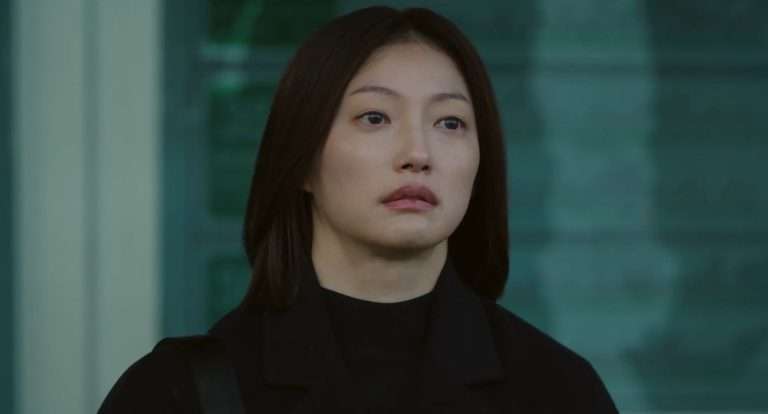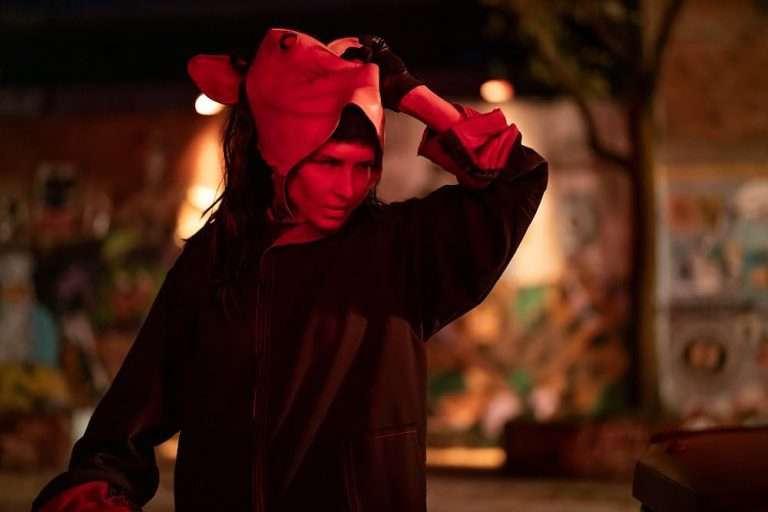Matt Shakman’s The Fantastic Four: First Steps is a luminous, retro-tinged superhero tale that shimmers with optimism yet hums with quiet melancholy beneath its glossy surface. Set in an imagined 1960s where four astronauts return from space carrying cosmic light that ushers in an age of peace, the film reimagines heroism as both miracle and burden. When that light begins to weigh on them, the story folds inward—becoming less about spectacle and more about parenthood, responsibility, and the impossible balance between saving one life or saving the world.
By its haunting finale, the film poses a piercing question: What does true heroism mean when every choice demands a sacrifice?
Spoilers Ahead
The Fantastic Four: First Steps (2025) Plot Summary and Movie Synopsis
In Earth-828 in the year 1964, Reed Richards, Sue Storm, Ben Grimm, and Johnny Storm are national icons. Their cosmic-ray accident made them heroes and symbols of hope. Reed’s inventions push science forward, and Sue’s work with the Future Foundation softens global politics. The world calms down because the Fantastic Four aren’t just superheroes; they are a promise. Their lives shift again when Reed and Sue announce they’re expecting a baby. Their unborn child becomes a global fascination. People cheer. News headlines wonder if the child will glow with cosmic power. Months later, that glow becomes a threat.
The Silver Surfer arrives from deep space and delivers a cold warning: Earth has been marked for destruction by Galactus. Reed studies patterns of vanishing worlds and realizes the threat is real. The team returns to space, tracks the Surfer’s energy trail, and arrives at a planet moments before Galactus consumes it.
They are captured inside his colossal ship, and Galactus explains his curse. His hunger is endless, a cosmic instinct rather than cruelty. But when he senses the power growing inside Sue’s unborn child, he offers a deal: give him the baby, and he will spare Earth. He triggers Sue’s labor to make the offer urgent. Reed and Sue refuse. The team escapes and slingshots toward home using the pull of a neutron star. Their FTL system burns out, but the gamble pays off. Sue gives birth to Franklin mid-flight, while the universe collapses behind them.
Why Does the World Turn on the Fantastic Four?
After they return, Reed openly explains what happened. He doesn’t hide the truth, believing transparency is the only way forward. But the honesty backfires. When people learn that the Four chose one child over the entire planet, something breaks in the public. Protests rise. Franklin becomes a symbol of selfishness in the eyes of frightened citizens. Reed believes the world can handle the truth, but the world is preoccupied with fear.
Sue, seeing anger build outside their home, makes her own choice. She walks out with Franklin in her arms and confronts the crowd face-to-face. She doesn’t try to win them over. Sue simply tells them she will not hand over her child. Her calmness changes the moment. She shows them that love is not weakness. It’s the reason she plans to save everyone, not abandon them.
What is Johnny’s Role in Understanding the Silver Surfer?
Johnny Storm, the most impulsive member of the team, takes on a surprising role. His earlier fights with the Silver Surfer weren’t just battles. There were moments when he noticed patterns in her speech. Small changes in tone. Symbols in her energy trails. He pieces these together with cosmic transmissions Reed intercepted.
He learns her name, Shalla-Bal, and that she once lived in the peaceful world of Zenn-La. She became Galactus’s herald not out of ambition, but because she offered her service in exchange for her planet’s safety. Johnny sees guilt in her. He hears it in the transmissions from worlds she guided to their doom. This recognition softens him. It pushes him to reach her when she returns and begins destroying the teleportation bridges. But remorse doesn’t mean she can disobey Galactus. Not yet. She flees because facing her guilt is harder than fighting the Fantastic Four.
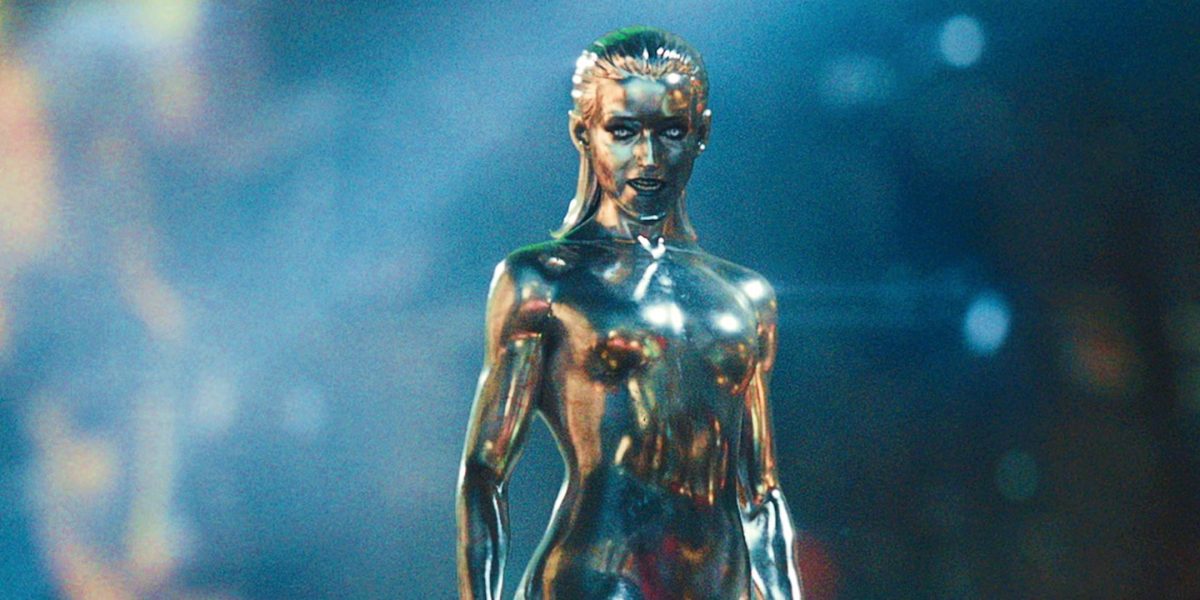
How Does Reed Plan to Save Earth?
Reed responds the only way he knows, with impossible engineering. He designs teleportation bridges capable of moving Earth to another solar system. Not the people. Not the cities. The entire planet. It sounds ludicrous, but this universe has trusted Reed’s ideas for years. Through the Future Foundation, Sue unites world leaders and scientists. Nations set aside conflicts because hope is easier when someone gives you a blueprint to hold on to. Ben Grimm oversees the physical construction. Johnny secures energy sources. Reed continues to push for a future he can still envision. The bridges activate worldwide. But time runs out.
Why Does the Final Battle Happen in New York?
The Silver Surfer begins destroying the bridges moments before Galactus arrives. The last functioning bridge remains in Times Square. The team decides to lure Galactus there using Franklin as the bait, and he cannot ignore it. It’s a disturbing plan, but it shows the team’s evolution. They no longer hide their fear. They confront it. Sue negotiates with Harvey Elder to evacuate New York’s citizens into Subterranea. She thinks of every life she can save while preparing to risk her own child in the trap.
When Galactus reaches the city, he bypasses the trap and captures Franklin anyway. Reed holds back panic. Sue doesn’t. She unleashes her full strength, pushing against a cosmic entity with nothing but will and invisible force. Reed dives in to save Franklin. Ben holds the ground. Johnny burns through every ounce of heat left in his body. But Galactus still stands.
Why Does Shalla-Bal Return, and Why Does She Save the Earth?
Johnny pushes the Silver Surfer to listen to the transmissions of the worlds she helped destroy. She hears their final moments. She faces herself. Shalla-Bal returns at the moment that matters. When Johnny tries to sacrifice himself to shove Galactus into the portal, she stops him. She knows the cost of martyrdom. Then she makes her own final choice. Shalla-Bal pushes Galactus into the portal with all the strength and sorrow she carries. The bridge closes behind them. She vanishes with him, and Earth is saved. It’s a redemption she never believed she deserved.
The Fantastic Four: First Steps (2025) Movie Ending Explained:
Why Does Sue Die, and Why Does Franklin Bring Her Back?
Sue’s power burns out after her massive push against Galactus. Her body collapses from the strain. Reed tries to hold her. Johnny and Ben stand silent for the first time in the film. But Franklin is not an ordinary child. His cosmic power awakens, raw and instinctive. The baby reaches toward Sue, and energy flows from him. He brings her back.
Obviously, the infant doesn’t understand what he’s done. He acts on love, the same love she fought with. Franklin becomes the symbol of the film’s final theme, that hope doesn’t require perfection. It only requires continuity. The world celebrates the Fantastic Four’s fifth anniversary. The team returns to duty, not as celebrities, but as survivors who stepped into cosmic history and returned changed.
The mid-credits scene cuts to four years later. Sue reads to Franklin at home. She leaves for a moment to fetch a different book. When she returns, a man in a green cloak and a metal mask stands before her son. This is the quiet beginning of something darker. Someone who has been waiting. Someone who understands the scale of Franklin’s power. A future threat has stepped into a peaceful moment.
“The Fantastic Four: First Steps” hides a family drama inside cosmic machinery. The film asks what parents owe their children, what heroes owe the world, and where compassion fits inside the vast emptiness of space. The Four save Earth not because they are stronger than Galactus, but because they never stop choosing each other, even when the world loses faith.
The Themes of The Fantastic Four: First Steps (2025) Explained:

“The Fantastic Four: First Steps” is a superhero story presented in the style of a family drama. It plays with cosmic ideas, but its heart lies in a simple question: what does responsibility look like when love and duty pull in opposite directions? Every major character carries a different answer to that question. Their motives form the film’s emotional structure, and the ending hints that these answers are about to collide with a new presence: Doctor Doom.
Reed Richards: Responsibility Without Limit
Reed Richards begins the film as someone who believes intellect can solve any problem. His identity revolves around solving problems. He builds machines that unite nations, technologies that end conflicts, and systems that make life easier. He wants a world where effort, logic, and foresight can prevent disaster.
But the arrival of Galactus forces Reed to face the limits of that belief. He cannot negotiate with hunger. Reed cannot calculate a safe option that protects both Earth and his unborn child. Reed’s arc becomes about accepting that some choices hurt, no matter how rational they are. His ultimate plan, to move Earth through teleportation bridges, is not just a scientific ambition. He attempts to honor two responsibilities at once: the future he wants with Sue and Franklin, and the duty he feels toward the world that trusts him. Reed’s theme is the burden of the “fixer,” the person expected to save everyone but who fears losing the people closest to him most of all.
Sue Storm: Love as a Moral Stand
Sue Storm represents the emotional core of the film. Her powers come from shielding others, and she stands for the courage to protect what you love even when the world turns against you. When the public demands Franklin’s sacrifice, the easy path would be to hide. Instead, she walks straight into the crowd with her newborn son. She does not beg for forgiveness or try to validate their anger. She simply stands there as a mother who will not trade her child’s life for anyone’s approval.
Sue’s journey is also tied to compromise. She has spent years guiding nations toward peace, slowly convincing people that unity is possible. But in the face of fear, that unity fractures. Sue learns that diplomacy has power, but love has its own form of strength, one that is grounded, personal, and painful. Her near-death at the portal is the final expression of her core nature. She pushes Galactus with the last of her power, not out of heroism, but out of the instinct to give her child a chance to live. Sue’s story is about the price of love and the resilience that comes from it.
Johnny Storm: Understanding the Enemy
Johnny begins the film looking like the least grave member, but the Surfer forces him to confront something deeper. He listens when others only fight. He studies her voice, her pauses, her unease. Johnny pieces together her history not through science, but empathy. His theme is recognition. He recognizes that Shalla-Bal is not simply an enemy of the cosmos. Moreover, Johnny realizes she is stuck in a pattern of guilt and obligation. His appeal resonates with her in the final confrontation, because he is able to see her accurately, even if she refuses to see herself. Johnny’s arc shows that an empathy shift can change the fate of a cosmic war even when physical strength is insufficient.
Ben Grimm: Grounded Loyalty
Ben Grimm anchors the team. His theme is steadfastness. He is the one who keeps Reed from disappearing into equations, who steadies Johnny’s fire, and who supports Sue without question. His presence reminds the audience that heroism also exists in those who don’t chase glory or solutions. Ben represents loyalty in its simplest, strongest form.
Silver Surfer / Shalla-Bal: The Weight of Compromise
Shalla-Bal embodies the cost of survival. She gave her life to save her planet, but that choice condemned countless others. Her remorse catches up with her only when she hears the voices of the worlds she helped destroy. She chooses in the end to stop Galactus, not because she believes she’s worthy of redemption, but because someone, Johnny, finally treated her like a person instead of a threat. Her theme is guilt turning into action.
Doctor Doom: The Shadow on the Horizon
The mid-credits scene shifts the theme toward the future. Doom appears before Franklin not with violence, but curiosity. This choice matters. Doom’s interest is not in Reed or Sue. It is in the child who revived a person, pushed back a cosmic force, and holds unshaped power. Doom’s theme is control. He represents the idea that power must be claimed, shaped, and directed.
Where Reed sees responsibility and Sue sees protection, Doom sees opportunity. Franklin is not a child to him. He is the future potential, raw, limitless, and dangerous. The moment Franklin interacts peacefully with Doom hints at a coming conflict: a child with infinite power choosing between the values of his parents and the ambition of a man who believes the world needs a ruler.

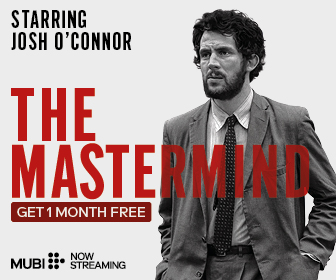

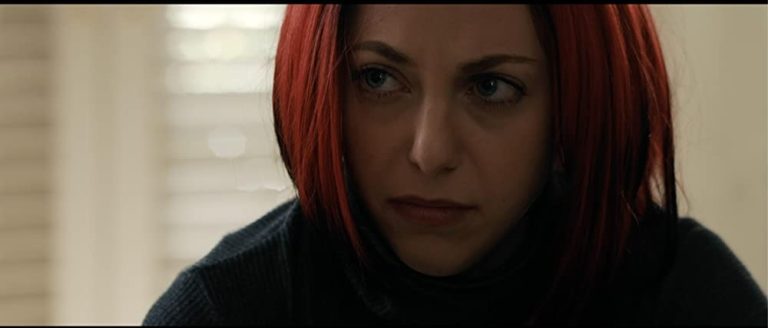
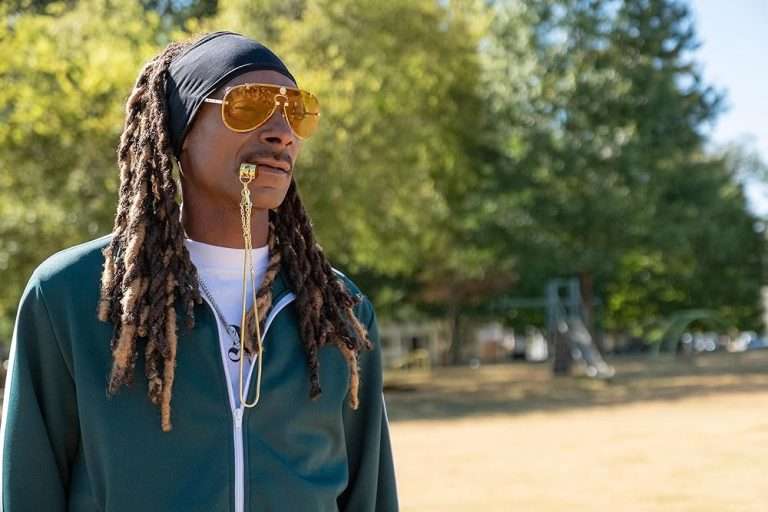
![Miss Americana [2020] Netflix Review- Purely for the “Swifties”](https://79468c92.delivery.rocketcdn.me/wp-content/uploads/2020/02/Miss-Americana-2020-Netflix-768x432.jpg)
